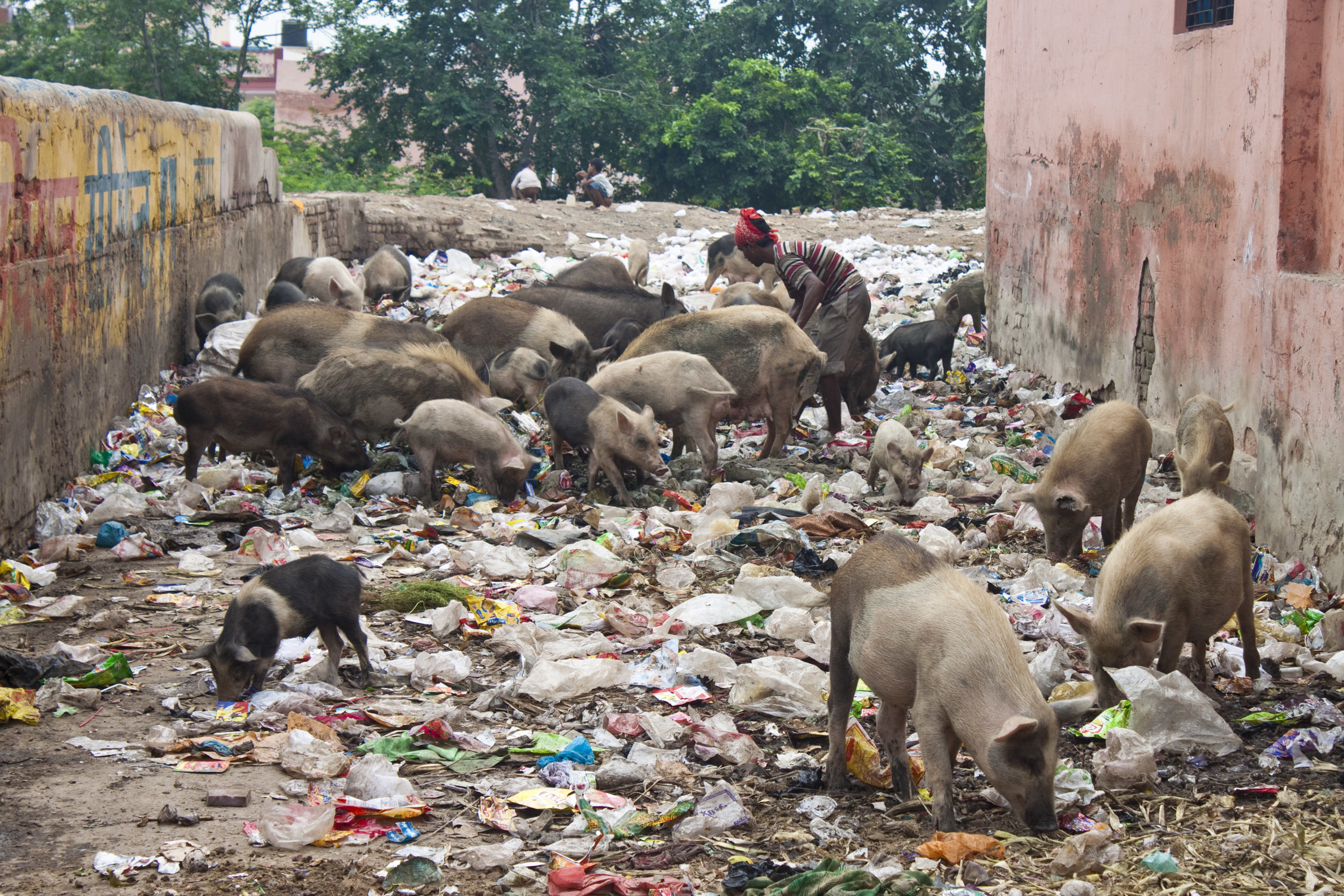



India making progress in developing hog industry
Pig farming in India has long had an image problem – but increasingly, cleaner, more efficient and up-to-date practices are raising its status, and bringing lucrative rewards for producers.A detailed inspection of India’s hog industry uncovers a nation of extreme situations. While still dominated by the north-eastern region’s refuse-fed pigs raised in simple pigsties to be sold in unorganised open marketplaces, scattered pockets of technologically advanced hog production units are appearing, mainly in the northern and extreme southern areas. The time-worn view of unhygienic practices, with meat being sold in fly-infested open marketplaces, remains entrenched in India – but a small and determined challenge to this picture is appearing on the horizon.
Steady and consistent growth
Crunching the numbers, the hog population of India had grown steadily over the last 50 years to 14 million in 2003 before dipping and holding just above the 10 million mark in 2018. Approximately 63 percent are raised in the poorer, less industrialised north-eastern region, with 70 percent reared under traditional low-input, demand-driven smallholder production systems, where animals are fed on available grains, vegetables, food scraps and kitchen waste. Although advances in recent years have been limited, production numbers have risen from approximately 370,000 to 390,000 tonnes between 2016 and 2018. Overall pork production is extremely limited accounting for only 8-9 percent of all meat protein produced, with virtually zero exported.
Genetics
Hindering growth in the industry is the fact that the smaller-framed, lesser-quality indigenous pigs have been at the core of the country’s production for decades. Although these animals are adapted to the variable climate conditions of the country, producers rearing them face the challenges of inbreeding, inferior reproductive rates and low gain margins.
Just over 20 percent of the pig population is cross-bred to imported breeds such as Hampshire, Yorkshire, Duroc, Landrace and Tamworth, mostly in the northern states. But even many of these pigs are not consistently bred to boost production, due to inconsistent and ill-defined management and technological practices.

“The need of the hour is genetically superior-quality animals, to enhance the farmer’s potential, meet consumers’ demand for safe and healthy meat, and [meet the] health industry’s requirement for quality animals. It is an industry with huge potential,” said Dr Nitin Malekar, director of Agri-Food Security & Healthcare Services, on behalf of Mumbai based Gargi Genetics, a private venture partially supported by the Maharashtra government. The company is currently working with farmers and Canadian-supplied hogs to create a comprehensive value chain accessing Canadian assistance and expertise in breeding, raising, marketing and business development. Land has been acquired in the Palghar district of Maharashtra and the company is in the process of raising equity funding for phase one to be officially kicked off in the second quarter of 2019.
Behind the scenes lurks the dark cloud of African swine fever (ASF), which spread across the globe in 2018 but remained outside of India’s borders. The 360,000-plus cases of the disease in 19 countries are a constant threat to derail any progress in the industry. “As long as hygiene is maintained and standards are adhered to, there is no need to fear,” said Tajinder Pal Singh, managing director of Polar Genetics India. He believes the key to preventing ASF’s advance into India is pig breeding versus pig rearing.
“In North India, in the states of Punjab, Haryana and Rajasthan, people like us are breeding swine. Ninety per cent of our stock is a Western, exotic breed like Yorkshire and Landrace. While breeding pigs, we strictly adhere to biosecurity norms. Seventy per cent of us use swine vaccines,” he said. “However, in the south and the north-east, the situation is different. Farmers in these regions raise pigs, mostly on garbage. There is the constant spectre of disease spreading among the swine in these areas. That is where precautions have to be taken.”
Issues facing India's pork producers
The vast majority of the country’s pork consumption occurs in the north-eastern regions taking the form of locally raised fresh pork meat. Very little is distributed through organised retail outlets. Throughout the rest of the country, consumption is nearly negligible. High-end hotels and restaurants cater to the wealthier Indian consumers, foreigners, international business travellers and tourists who largely consume imported pork produce in the form of cured and canned meats, bacon, ham and sausages.
There are benefits to rearing and breeding pigs in India. While keeping a focus on improving the technology, work processes and farm management practices, these include high profitability and revenue due to lower feed costs, rising demand, plus availability and high prices of other substitute red meats. The self-employment and poverty alleviation it provides are real opportunities for farmers – providing strategic control and eradication of disease remains front and centre, while the industry slowly moves from extensive to intensive commercial systems of agriculture.
But many negatives still exist for the hog industry. Most pig farmers belong to lower socio-economic strata and, due to the lack of regulations, disease occurrences can cause heavy economic losses in terms of production. Insufficient numbers of quality slaughter and processing facilities, limited amounts of passable feed, weak supply chain and marketing strategies, availability of vaccines, absence of a national traceability programme and low levels of quality breed upgrades are creating a low productivity index with respect to potential growth rates. The cultural bias of the majority of the Indian population, which portrays pork products as being raised in an inefficient, unorganised and unhygienic way, continues to block progress, although its foundations are beginning to erode.

A better future for pork
Since 1973, India’s domestic meat production and processing has been governed by the Meat Food Products Order (MFPO) which establishes sanitary and hygienic standards for slaughterhouses and sets residue levels for meat products. However, the recently created Food Safety and Standards Authority of India (FSSAI), has brought the MFPO under the umbrella of its regulations. It is hoped that, together with any peripheral effects of the government’s National Action Plan, sanitary and environmentally safe pork production can be radically increased and access to export opportunities established, raising the incomes of pig farmers and entrepreneurs.
It is predicted that over the next 10 years, along with a significant rise in population, the average citizen’s income will increase, prompting an improvement in lifestyles including an increase in the quality of food purchased. Pork consumption is expected to double.
Dr Malekar, speaking for Gargi Genetics, stressed that to make the best use of land and water resources, the genetics of the breeding programmes must be upgraded, rather than drastically increasing the total number of pigs.
“We will use public education channels to spread awareness about pork meat and its benefits. We strive to change the public image of pork and bring quality products to the consumer’s kitchen,” he said.
India’s pork industry is slowly shedding its stigma, and its status in Indian culture is gradually improving. While still dominated in numbers by the poorer economic classes, the scenario is changing, and commercial pig farming is becoming a more commonplace and acceptable occupation. As India moves to a more viable production of pigs through cross-breeding of exotic stock, it is imperative that technology is utilised, sound herd management systems are adhered to and healthy, clean, disease-free environments become the rigid standard. The social status of India’s pig farmers – and financial rewards for them – will continue to grow along with the country’s acceptance of pork as a suitable and safe animal protein.









